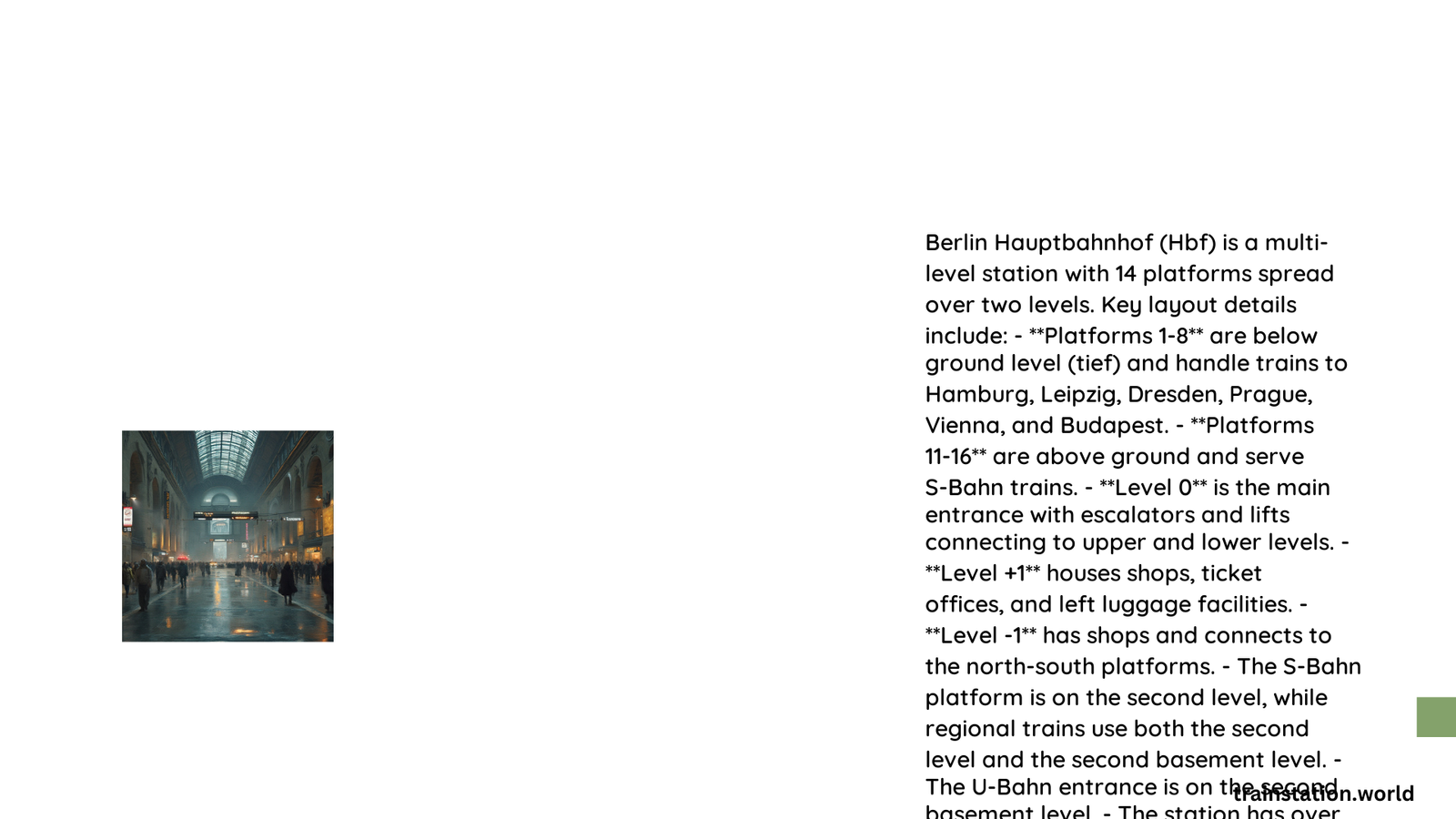Berlin Hauptbahnhof, the main railway station in Berlin, is a marvel of modern architecture and efficient design. The station’s layout spans multiple levels, integrating various modes of public transport. With its unique cross-shaped structure, it connects north-south and east-west rail lines, serving as a crucial hub for both local and international travel. The berlin train station layout features elevated and underground platforms, extensive shopping areas, and state-of-the-art accessibility features, making it one of Europe’s most advanced railway stations.
What Are the Key Features of Berlin Train Station Layout?
The Berlin Hauptbahnhof layout is characterized by its multi-level design and integration of various transport modes. Here are the key features:
- Two main platform levels:
- Upper level (Obergeschoss): Platforms 11-16
-
Lower level (Tief): Platforms 1-8
-
Multiple concourses:
- Street level (Erdgeschoss)
- Below street level (1 Untergeschoss)
-
Upper concourse (1 Obergeschoss)
-
Extensive shopping and dining areas
- Integrated accessibility features
- Connection to U-Bahn and S-Bahn services
How Are the Platforms Arranged in Berlin Hauptbahnhof?

The platform arrangement in Berlin Hauptbahnhof is designed to efficiently handle different types of train services:
| Platform Numbers | Level | Train Services |
|---|---|---|
| 1-8 | Underground | Regional and intercity on North-South mainline |
| 9-10 | Underground | Reserved for future S21 S-Bahn line |
| 11-14 | Elevated | Regional and intercity on Berlin Stadtbahn |
| 15-16 | Elevated | S-Bahn services on Stadtbahn |
Each platform is equipped with:
– Elevators and escalators for accessibility
– Train composition posters (Wagenreihungsplan)
– Information displays
What Amenities Are Available at Berlin Train Station?
Berlin Hauptbahnhof offers a wide range of amenities to cater to travelers’ needs:
- Restrooms and showers (street level concourse)
- DB 1st class lounges (upper concourse)
- Ticket counters and Reisezentrum (upper concourse)
- Over 80 shops and stores, including:
- Cafes
- Restaurants
- Retail outlets
- Left luggage lockers (upper and lower concourses)
- Information desks
- Car hire desks (street level concourse)
How Does the Berlin Train Station Layout Enhance Accessibility?
The Berlin train station layout prioritizes accessibility through various features:
- Elevators:
- Connect specific platform pairs
-
Ensure step-free access between levels
-
Escalators:
- Link multiple levels
-
Facilitate easy movement throughout the station
-
Tactile guidance systems (presumed, based on overall accessibility focus)
-
Assistance services:
- Information desks
-
Staff available to help travelers with mobility challenges
-
Clear signage and information displays
What Makes Berlin Hauptbahnhof’s Design Unique?
Several elements contribute to the uniqueness of Berlin Hauptbahnhof’s design:
- Cross-shaped structure:
- Integrates north-south and east-west rail lines
-
Creates a visually striking architectural landmark
-
Glass roof with integrated photovoltaic system:
- Contributes to energy efficiency
-
Allows natural light to penetrate the station
-
Multi-level design:
- Efficiently utilizes space
-
Separates different types of rail services
-
Extensive commercial areas:
- Transforms the station into a shopping and dining destination
-
Provides convenience for travelers
-
Integration of multiple transport modes:
- Seamless connections between long-distance, regional, and local services
How Does the Berlin Train Station Layout Facilitate Passenger Flow?
The Berlin train station layout is designed to optimize passenger flow through several key features:
- Multiple access points:
- Main entrance on the south side
-
Additional entrances at each end of the street level concourse
-
Strategically placed concourses:
- Street level concourse for general navigation
- Below street level concourse for U-Bahn connections
-
Upper concourse for access to elevated platforms
-
Clear signage and information displays:
- Guide passengers to their desired platforms or services
-
Provide real-time updates on train schedules
-
Efficient vertical circulation:
- Elevators and escalators positioned for easy level changes
-
Reduce congestion and facilitate smooth passenger movement
-
Separation of long-distance and local services:
- Helps manage different passenger flows
- Minimizes crowding on platforms
By implementing these design elements, the Berlin train station layout ensures that passengers can navigate the complex facility with ease, even during peak travel times.
